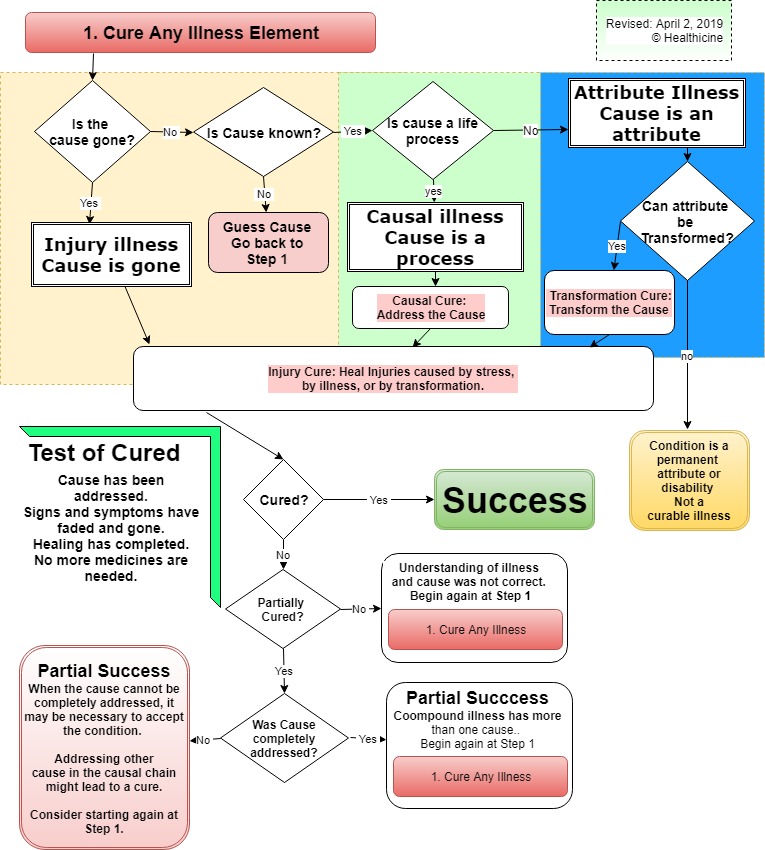“Physicians of the Utmost Fame, Were called at once; but when they came
They answered, as they took their fees, ‘There is no cure for this disease.”
– Hilaire Belloc, Cautionary Tales
In May 2016, I published the Science of Cure: How to Cure Any Illness, with a flow diagram to cure. Since that time, I have reviewed and revised, simplified and clarified the post and flow diagram. This post presents an updated diagram. This diagram represents the steps to cure any curable illness, and to determine if any illness cannot be cured, using the healthicine definition of cure.
I have begun to write out detailed descriptions for each of the boxes, however, the explanations are much longer than could be included in a single blog post. So…. I am publishing the diagram here – and will explore each of the elements of the diagram in several subsequent blog postings. In this post, I will make some general comments about curing illness, and the diagram in general.
In healthicine, ‘illness’ is defined as ‘that which can be cured’, and injury, disability and handicap as ‘that which might be healed’. How can we tell if a condition is an illness or a disability? We can only try. Illness, disability, handicap, are judgments, not clearly defined in healthicine or medicine. What one person might see as a medical condition, another might see as a natural feature or even a benefit.
The first step in separating an illness, which can be cured, from a disability, which might be healed, is to look for an active cause. If an illness is progressing steadily, there is probably an active cause. If there is an active cause, it can be addressed – and the illness can be cured.
If we judge a medical condition to be an illness with an active cause, we are saying it is curable. We can then proceed with attempts to cure it. If we decide, later, that it is incurable – it is re-classified as a handicap, a disability or a deficit.
If we judge a medical condition to be a disability, then we are saying it is incurable. If we judge something as incurable, it is not an illness – it is a disability, a handicap, or a deficit. However, if we learn to cure it, or succeed in curing it, we have recognized that our initial classification was wrong – it was actually an illness.
Modern medicine does not distinguish clearly between illness, disease, medical condition, disability, etc. All, and more, are classed as ‘diseases and related health problems’ in the ICD10, the International Classification of Diseases. Medical reference texts like MERCK’s Manual of Diagnosis and Treatment, Harrison’s Principles of Internal Medicine, and Lange’s Current Medical Diagnosis and Treatment advise how to ‘treat’, but seldom use the word ‘cure’. Medical science does not attempt to cure most diseases. ‘Cured’ is not scientifically defined for most diseases and therefore cannot be tested, cannot even be officially recognized when it occurs in most cases.
Note: we do not cure the patient – any single patient might have many illnesses at once. Only an illness can be cured. One at a time.
To cure any illness, and prove that a cure has been accomplished, ‘cured’ must be defined in a testable fashion. If cured is not defined, it does not mean that a cure is not possible, only that cured is not yet defined. Is it possible to define cured for every illness? Yes.
But today, unless you have an infection, cured is not defined for your illness. The fact that cured is not defined does not mean your illness cannot be cured, only that you cannot prove it has been cured, and that your illness cannot be cured with medicine.
Cured is when the cause has been addressed. When the cause has been successfully addressed, the illness has been cured. This is how all cures work – there are no exceptions.
It’s easy to fall into the philosophical traps of cause and effect. What caused the illness? Did it really cause the illness? How do we know it caused the illness? If we study the philosophy of cause and effect, we find a quagmire, where some philosophers even claim that cause and effect does not exist.
Philosophy is theory, and curing is practice. In theory, theory and practice are the same. In practice, they are not.
When an illness is cured, by addressing the cause, no one – doctor, patient, or family cares if the philosophers argue about cause and effect.
A cure is a cure.
to your health, tracy
Diagram Updated: April 3, 2019



